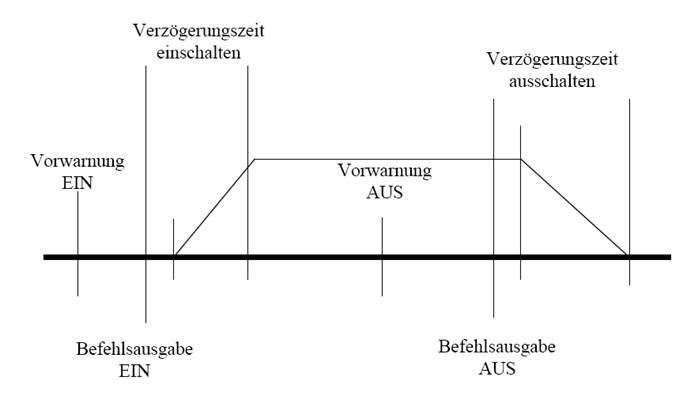Switching process |
|
Manual -> Energy Management System (EMS) -> Method of the EMS -> Operating principle of the obtaining rule -> Switching process |
  |
Switching process |
|
Manual -> Energy Management System (EMS) -> Method of the EMS -> Operating principle of the obtaining rule -> Switching process |
  |
The term switch-off request on the part of the optimization always refers to the reaction of the device which decreases the needed output and therewith the obtained output because it is switched-off. Therefore the request for the switch-off can be fulfilled by switching on an aggregate.
Processes during a switching

Delay time for the switch-on (switch-on dead time)
Equals the time period from activating the switching order until the nominal power is reached.
This time - dependent on the aggregate - can be quite long; e.g starting up the aggregate und synchronization, rearwards controlled heating etc.
Delay time for the switch-off (switch-off dead time)
Time period from activating the switching order until the output is zero. You must add the time of the activation of the switching order to the time when the total output is zero.
Forewarn time for the switching-on and the switching-off (length of forewarn time)
The switching times are planned to a second in order to exactly control the amount of energy. In order to give the user the opportunity to adhere to the times in the open-loop operation a certain lead time to carry out the switching is necessary. This is defiend by Duration pre-warn time. Hereby the user receives information about switchings which are planned before they are actually carried out.
|
|
|
As the EMS assumes that the switchings are carried out, the suggested switchings should be carried out in the corresponding time in respect to the exactness of the forecast. |
Tactic of the switching schedule
In general the switching selection happens in a away that as few switchings as possible are carried out. This calms the grid operation and keeps up the availability of the devices whose use are limited by a maximum of switchings. In addition conflicts are minimized which can occur at the command output of the switchings.
The use of components with a much higher output than that is used for the correction is possible by a specific time control. The components are used for such a short time that the compensate the needed output.
Suppressed switchings at the beginning of a measuring period
At the beginning of a measuring period it is possible that larger switchings are carried out or large deviations to the actual output average value are set in order to compensate large amounts of energy at the end of the period. That is way it is necessary at the beginning of the period to give the system the opportunity to adjust itself to the new circumstances.
That is why a Down time begin tariff interval can be engineered in the system. During this time the optimization doe not carry out any switchings.
|
|
|
If for a long time no response is received for a switch command which was issued by the EMS (on the response variable), the EMS assumes that the action failed und tries to carry out another switching (on the next available component). Therefore you must always ensure that the correct response about the success of a switchng operation is transferred to the EMS. |